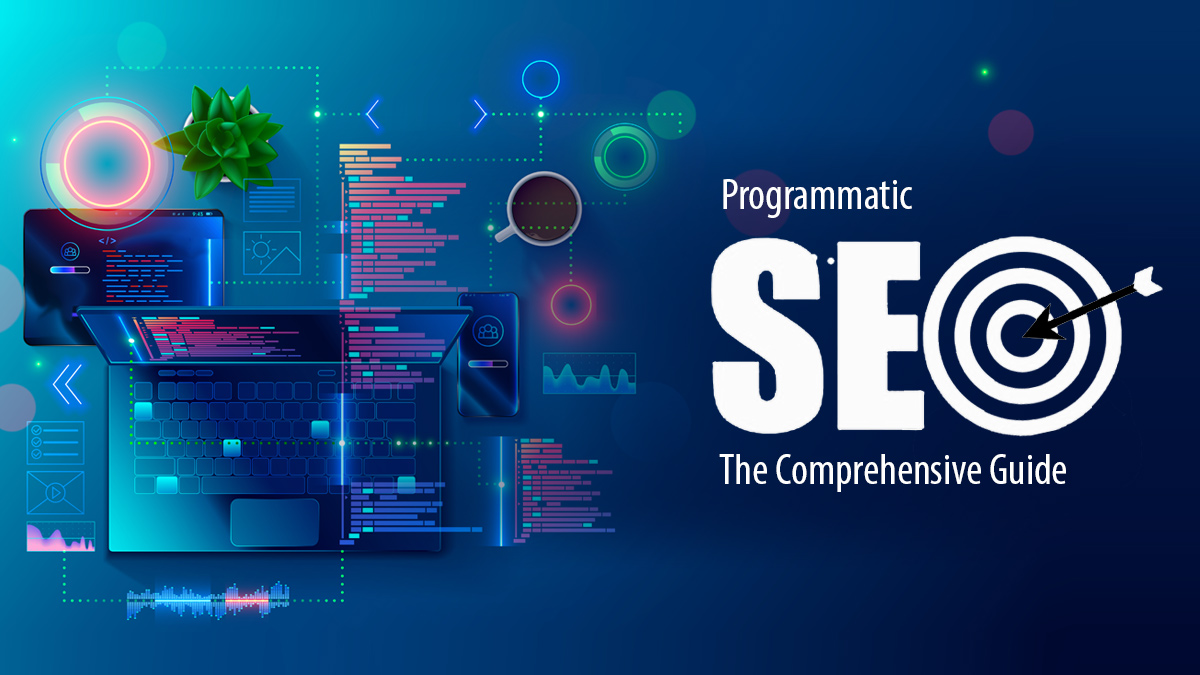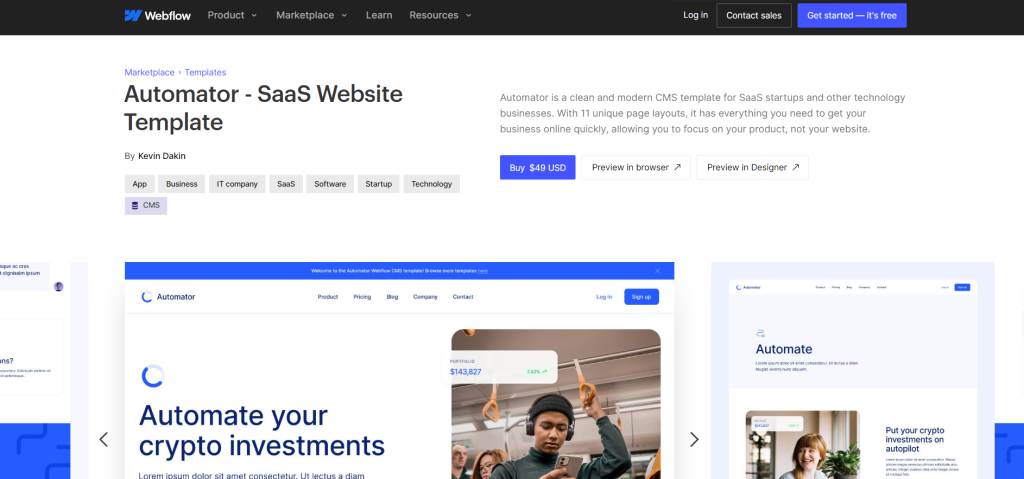Step into the world of cutting-edge SEO strategies and exceptional content creation. In today’s digital landscape, producing content that not only captivates your audience but also achieves top rankings on Google is vital. Imagine being able to generate 1,000 pieces of high-quality content within the same time frame it would usually take weeks or months. That’s the transformative power of automated SEO.
Navigating the complex realm of SEO is essential for widening your website’s reach. While it demands patience and sustained effort, the rewards become clear as you consistently churn out exceptional content over an extended period. However, the real challenge is the time and resources needed to create a high volume of blog posts. Essentially, your options are to either invest considerable time crafting the content yourself or allocate a significant budget to employ an agency.
Enter programmatic SEO, an underrated yet highly effective method that streamlines this labor-intensive process. It enables you to rapidly publish hundreds, or even thousands, of SEO-optimized pages in days instead of months. Leading companies like Zillow, Zapier, and Tripadvisor have strategically adopted programmatic SEO, making it a fundamental component of their marketing arsenal and propelling them toward billion-dollar valuations.
If you’re new to the concept of programmatic SEO, fret not! This guide serves as your exhaustive resource, helping you launch your journey into the world of programmatic SEO, regardless of your budget constraints.
Let’s delve into the guide:
- Understanding Programmatic SEO (Informational): Familiarize yourself with the core principles of programmatic SEO, its significance, and gain insights through real-world success stories.
- Tactical Step-by-Step Guide: For those already versed in programmatic SEO, proceed to this section for an all-encompassing guide on how to execute this strategy using no-code platforms. Benefit from the expert advice and insights provided by Barrett O’Neill of Brightline Social throughout the implementation process.
By the end of this guide, you’ll possess a concrete methodology for generating thousands of programmatic SEO pages in just days—a task that previously required months of collaborative work from engineering and design teams. Thanks to the featured no-code platforms, your first batch of pages can be live in merely a few hours. Welcome to the future of SEO—efficient, effective, and scalable.
SEO agencies are increasingly adopting programmatic SEO techniques to automate and scale their search engine optimization efforts. Utilizing data-driven algorithms and automated workflows, programmatic SEO allows agencies to handle large and complex websites more efficiently, optimizing multiple aspects of SEO simultaneously.
Understanding Programmatic SEO
What Is Programmatic SEO?
What SEO Means
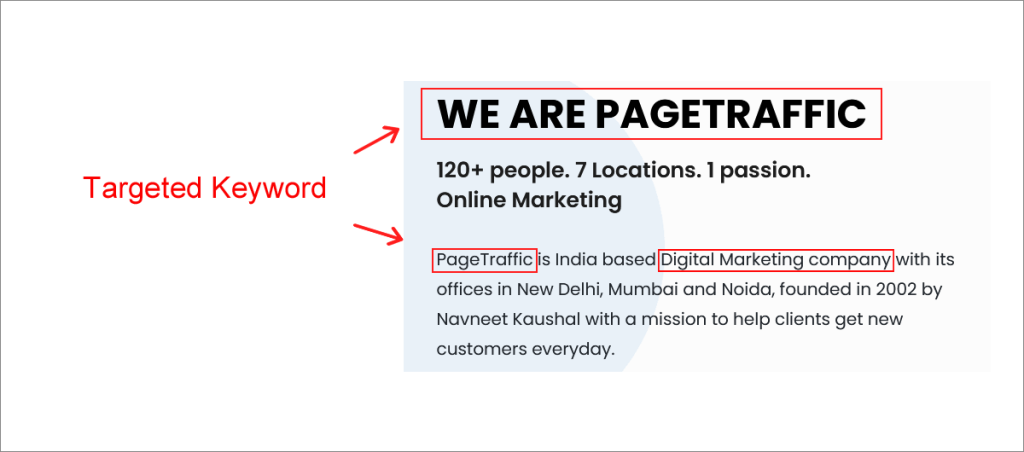
First, let’s demystify traditional SEO. This approach involves optimizing your website to ensure that specific pages earn high rankings on search engines like Google. Generally, this means creating blog content that targets certain keywords. For instance, this very post is optimized to rank for the keyword “PageTraffic.”
What Programmatic SEO Means
Now, let’s turn our attention to Programmatic SEO, which you could consider the fast-paced chef of the digital marketing kitchen. Unlike traditional methods, which require meticulous crafting of each blog post, Programmatic SEO employs data and automation to produce multiple posts at once.
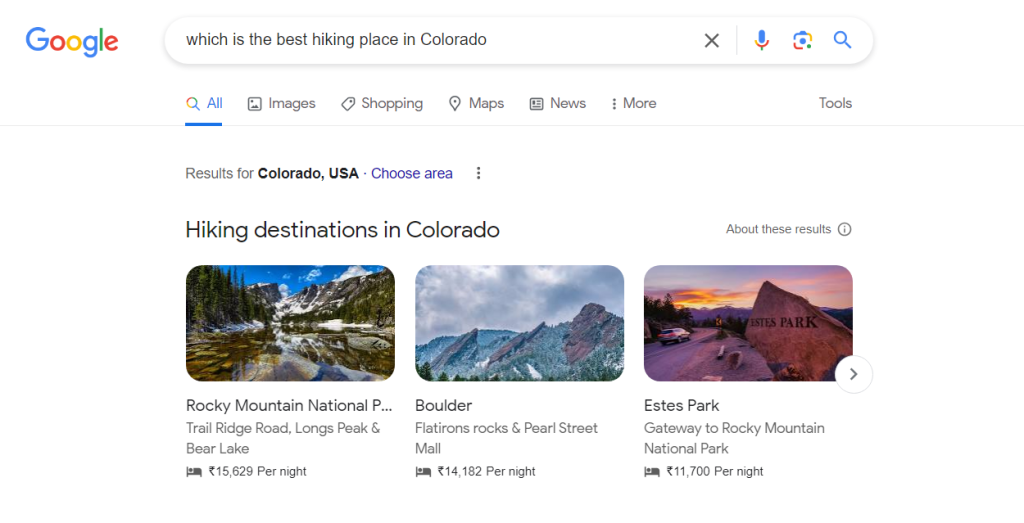
Imagine you’re searching for “which is the best hiking place in Colorado.” You will find a page from an outdoor adventure website that provides a comprehensive list of the best trails. Here comes the twist: perform another search, this time for “which is the best hiking place in [any city].” Magically, the same adventure-focused website still occupies the top spot in the search results.
They didn’t commission a writer to create a unique post for each city—doing so would be impractical and time-consuming. Instead, they used Programmatic SEO to quickly produce multiple variations of a single template page. It’s akin to having a kitchen that can instantly adapt a single recipe to suit various tastes. The true allure of Programmatic SEO lies in its efficiency and its unparalleled capability to earn top rankings on Google with minimal effort.
The Importance of Programmatic SEO
Why SEO Is Beneficial
Utilizing SEO to attract clients offers a practical and cost-efficient approach. Unlike paid advertising, where costs can accumulate over time, an initial investment in SEO can sustainably attract new customers. Once you’ve achieved high search rankings, you don’t need to make ongoing payments to Google to maintain them. Companies like HubSpot, Canva, and Airtable invest heavily in content creation and SEO for this very reason.
The Issue With Conventional SEO
However, when it comes to scaling, traditional SEO has its drawbacks. Crafting a single high-quality blog post can consume days, if not weeks, of work. To produce a library of a thousand such articles would take months or even years, requiring a large and dedicated content marketing team. While the ROI for SEO is often favorable, the process of creating rank-worthy content is both labor-intensive and expensive.
Why Is Programmatic SEO so Effective
Programmatic SEO offers a way around the time-consuming process of crafting SEO content one page at a time. When implemented correctly, this method allows you to generate and rank thousands of landing pages swiftly. Not only does this broaden your marketing reach, but it also does so in a cost-effective manner. Considering the rising costs of paid advertising, programmatic SEO emerges as a compelling alternative for businesses that possess the necessary creativity and technical know-how.
Why Programmatic SEO Works Well
While programmatic SEO may seem like a cure-all solution, let’s set the record straight: mastering it isn’t as simple as it may appear. Despite its promise, doing programmatic SEO work requires a deep understanding of its mechanics.
So, what factors contribute to the efficacy of programmatic SEO? Essentially, it’s a triad of fundamental SEO concepts:
- Keyword Difficulty: Understanding the competitiveness of ranking for a particular keyword is vital.
- Keyword Volume: It’s important to know how many people are searching for the terms related to your offerings.
- Bottom of the Funnel (BOFU): This is where the conversion magic happens. Finding the right balance here is crucial.
Don’t underestimate the intricacies involved; truly benefiting from programmatic SEO requires genuine effort and comprehension of these key concepts. Let’s delve deeper into each one:
Keyword Difficulty
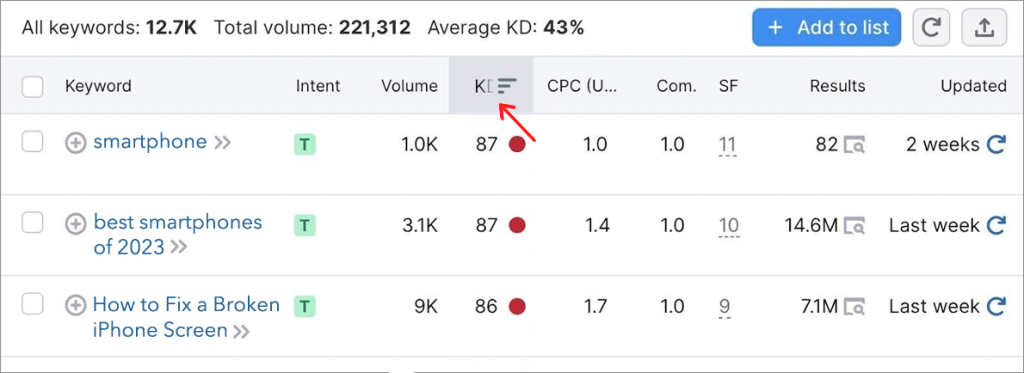
When you search for information online, particularly if it’s tech-related, each term or phrase you enter into a search engine like Google is assigned a “keyword difficulty” score. This score is an indicator of how hard it will be for your content to rank high in search results for that specific keyword. A higher keyword difficulty score means stiffer competition.
Let’s look at some examples for clarity:
- “Smartphone”: This is a highly competitive keyword. A multitude of websites and businesses vie for the top spots in search results for this term, resulting in a high keyword difficulty score.
- “Best smartphones of 2025”: This is a more niche term and therefore, less competitive. It targets a specific audience looking for the latest models, leading to a lower keyword difficulty score compared to the term “smartphone.”
- “How to Fix a Broken iPhone Screen”: This term is even more specialized and less competitive. People searching for this are looking for a specific solution, making the keyword difficulty score relatively lower than the previous examples.
In summary, understanding keyword difficulty helps website owners and content creators decide which keywords to target. It enables them to gauge the competition and strategically focus their efforts to improve search engine rankings.
Keyword Volume
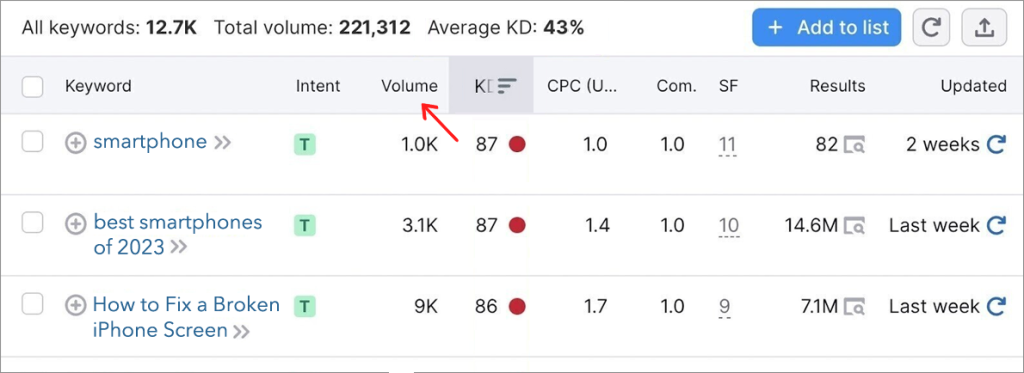
Navigating the landscape of SEO involves more than just understanding keyword difficulty; the concept of “keyword volume” is equally crucial. This term refers to the number of times a particular keyword is entered into search engines each month.
Here’s the thing: High-volume keywords are often more challenging to rank for. Think of it as a crowded marketplace. If many people are competing for the same keyword, numerous businesses are likely also vying for that same search term, increasing the level of competition. In the online arena, this creates a competitive frenzy.
Bottom of the Funnel (BOFU)
Visualize your online sales process as a funnel that captures the journey potential customers take, from initial awareness of your brand to making a purchase. At the top of the funnel (TOFU), you have a broad audience—let’s say, 1,000 visitors to your website. As these individuals move down the funnel, the number narrows—100 might click through to a specific page, and eventually, 10 make a purchase.
Content plays a crucial role at various stages of this funnel. TOFU content focuses on increasing brand awareness and visibility. It’s about making people aware that you exist and what you have to offer.
As individuals progress down the funnel, they become more engaged and interested in your offerings. This is where BOFU content comes into play. This material is strategically crafted to convert those who are already knowledgeable about your products or services and are contemplating making a purchase.
Think of TOFU content as a casual introduction where you make a first impression. In contrast, BOFU content is akin to deeper, more meaningful conversations that address specific needs, provide detailed information, and ultimately guide the potential customer toward making a decision.
In summary, understanding and creating effective BOFU content is vital for converting customers who have moved past the awareness stage and are prepared to take the next step in their buying journey. It’s about delivering the right information at the opportune moment to facilitate decision-making.
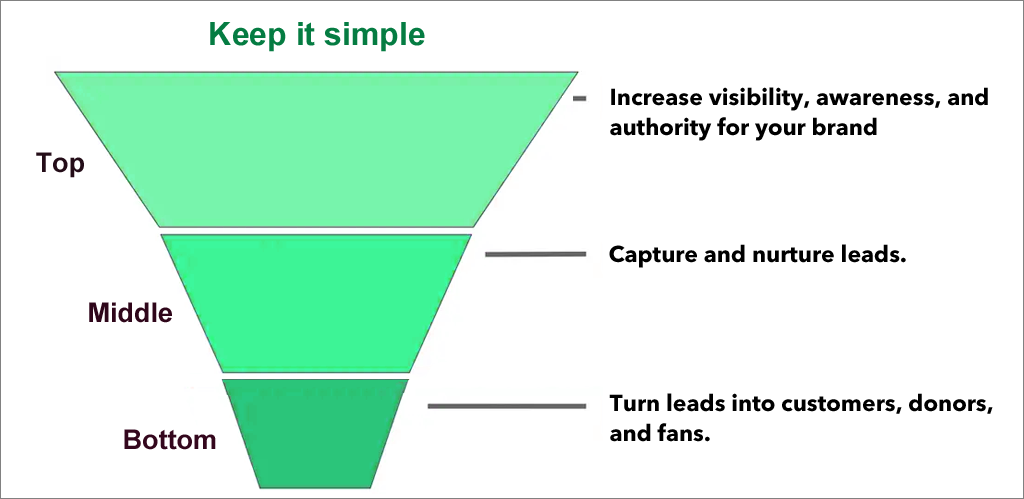
Low Keyword Difficulty, BOFU Content for Programmatic SEO
In essence, programmatic SEO focuses on targeting less competitive keywords that have the potential to attract customers. Imagine effortlessly discovering thousands of such keywords. On their own, each may not generate a flood of traffic, but collectively, they can have a substantial impact.
Take Zapier as an example. They employed programmatic SEO to optimize multiple web pages for keywords like “Connect Salesforce and Trello.” This tactic is clever because each specific tool combination doesn’t usually garner a high search volume, leading to low keyword difficulty. However, the cumulative search volume of all these combinations can be significant.
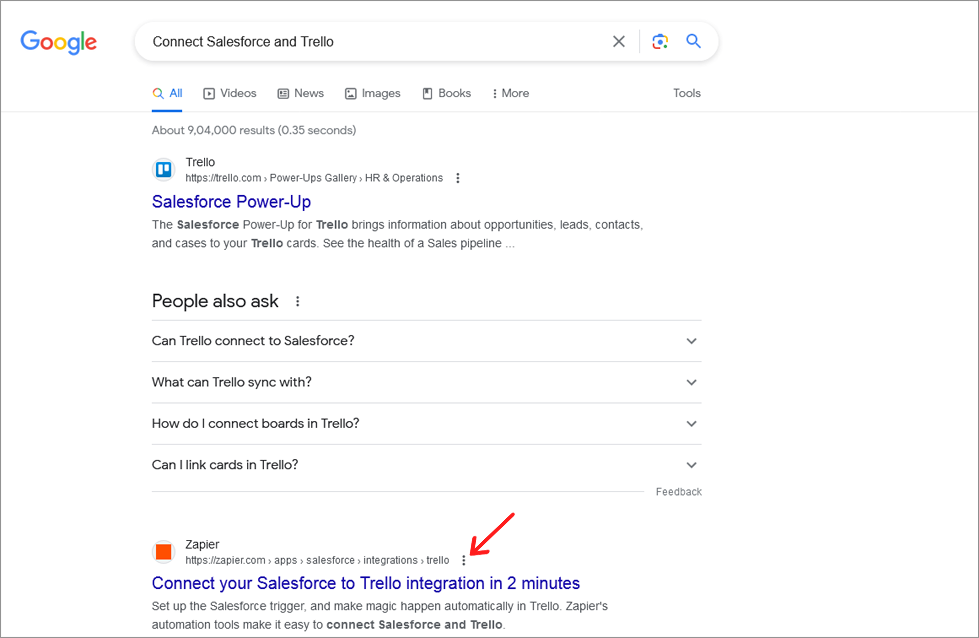
Moreover, those who search for these terms are generally further down the funnel and closer to making a purchase. They aren’t interested in a lengthy guide; they seek an immediate, actionable solution. It’s a strategic move that can yield long-term benefits.
User Experience Is Key
Regardless of the SEO strategy you choose, providing an excellent user experience is crucial. Programmatic SEO is no different; it’s all about fulfilling the user’s search intent effectively. In other words, you can’t trick Google. Zapier’s success in this area, for example, comes from satisfying the needs of people looking to integrate various tools. To make programmatic SEO effective, well-designed landing pages that genuinely meet users’ needs are essential.
Examples of Successful Companies Using Programmatic SEO
We’ve touched on companies like Zapier and Tripadvisor, but let’s expand the list to spotlight additional organizations that have successfully leveraged programmatic SEO:
- Wise: Specializes in currency exchange, focusing on “{currency} to {currency} exchange rates.”
- Realtor.com: A hub for real estate featuring “apartments for sale in {city}.”
- Porch: Connects users with leading “{job}” opportunities in specified cities.
- Canva: Known for user-friendly design templates tailored for different “{use cases}.”
- G2: Offers insights into “top {app} alternatives.”
- Eater: A haven for food enthusiasts, featuring guides on the “best restaurants in {city}.”
- Booking.com: Your go-to platform for “hotels in {city}.”
- Payscale: Provides data on “average {job title} salaries.”
- DelightChat: Guides users to the “best {app type} for {app}.”
- Nomadlist: A resource for those seeking ideal living conditions, showcasing “best places to live in {city}.”
- Glassdoor: A platform for job seekers, offering insights into “{job title} salaries.”
- Nerdwallet: Assists users in selecting the “best {credit card type}.”
- Airtable: Features customizable templates for various “{use cases}.”
- Zapier: Specializes in cybersecurity, particularly “{open source vulnerabilities}.”
- Snyk: Focuses on cybersecurity, specifically “{open source vulnerability}.”
- Tripadvisor: Focused on local experiences, offering valuable information on “things to do in {city}.”
Each of these companies exemplifies the versatility and effectiveness of programmatic SEO in its own unique way.
Example Programmatic SEO Categories
In examining the previously listed companies, certain recurring themes emerge concerning effective keywords for programmatic SEO. Here are some widely-recognized categories:
- Locations (e.g., TripAdvisor): Focuses on specific geographical areas.
- Top 10s (e.g., DelightChat): Highlights the best options in a particular category.
- Unique Data (e.g., Snyk): Showcases specialized information.
- Integrations (e.g., Zapier): Emphasizes compatibility with other platforms or tools.
- Comparisons (e.g., G2): Discusses differences in features or performance between options.
- Templates (e.g., Airtable): Offers pre-designed formats or structures.
What Makes Programmatic SEO Special in 2025
While programmatic SEO has been impactful for years, what’s particularly exciting is its newfound accessibility. In the past, implementing a programmatic SEO strategy required assembling a team of engineers and designers and dedicating months to preparation. In contrast, 2025 offers the ability to set up programmatic SEO using platforms like Airtable, Webflow, and Whalesync for under $100 per month!
This shift towards autonomously generated web pages is accelerating. With advances from OpenAI, you can now create not just hundreds but thousands of pages, each featuring unique AI-generated content. SEO experts are leveraging platforms like Whalesync and OpenAI to multiply impressions by a factor of ten in just a matter of weeks. We’ll delve into exactly how to replicate these results in the second part of this article, so stay tuned!
Programmatic SEO Tools
Key Tools – Literally Everything You Need to Accomplish Programmatic SEO
- Airtable: Serves as your database for storing content for programmed pages.
- Whalesync: Acts as a synchronization engine, linking the data in your database to templated web pages on a large scale.
- Semrush: An excellent resource for keyword research.
- Webflow: Useful for creating templated web pages that can be populated with your data.
Advanced Tools – Take it to the Next Level
- OpenAI: Leverage AI to generate content for your website.
- Data Fetcher: Streamline the process of importing data into Airtable, including content from OpenAI.
- Abyssale: Automatically generate images for each of your pages.
And for More Options, Consider
- CopyAI: Another resource for AI-generated content.
- Ahrefs: A solid alternative for keyword research.
- Placid: Perfect for bulk image creation.
- Jasper: An AI tool for content creation.
- ScrapingBee: An API-based tool for web scraping.
- WordPress: A well-known website-building platform.
Also Read: Ahrefs Vs Semrush: Which SEO Tool Is Better And Why?
How to Do Programmatic SEO – A Step-by-Step Guide
There are two primary steps in setting up programmatic SEO pages. First, you’ll need to perform keyword research to identify the terms you want to target. Next, create web pages tailored to each of these keywords.
If you’re new to the game, the whole process might seem daunting. However, rest assured that while programmatic SEO can be challenging, it’s not insurmountable. In our upcoming post, we’ll provide a comprehensive guide covering all you need to know to get multiple programmatic SEO pages off the ground.
Step 1: Conducting SEO Research
- Find Inspiration
When embarking on a programmatic SEO campaign, the objective is to pinpoint a broad array of keywords that are relatively easy to rank for. If this seems like a tall order at first, here’s a tip: look to successful SEO campaigns of the past for inspiration.
Most opportunities in programmatic SEO fall into one of two categories: location-based pages or unique data sets. Revisit the examples provided in the earlier sections to spark your creativity before diving into your strategic planning. This exercise can serve as an effective warm-up for your brainstorming sessions.
- Find a Head Term
After establishing a general direction for your campaign, the next step is to find a “head term.” This term represents the broad category you aim to rank for. Your goal is to identify a head term that can be adapted into a multitude of related keywords.

These head terms are effective because each variant caters to a unique search intent. For instance, the search results for “things to do in Munich” will differ substantially from those for “things to do in Barcelona.”
To pinpoint relevant head terms, put yourself in the shoes of your prospective customers. What might they search for? What information would they find valuable? Tools like Ahrefs and Semrush can be invaluable at this stage. Use their “organic research” feature to see which keywords are performing well for companies in your industry.
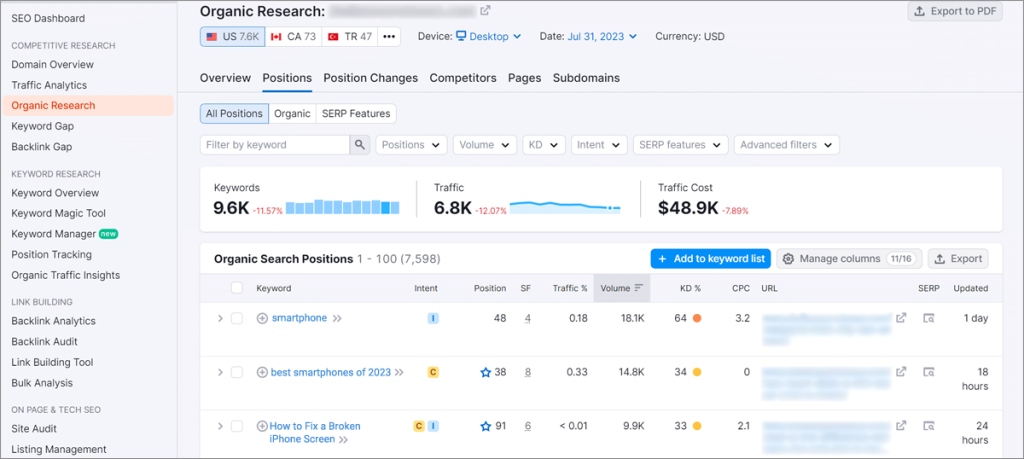
Keep in mind that this could be one of the most challenging steps in the entire process. Crafting the right head term requires both time and creativity, so don’t be too hard on yourself if the perfect term isn’t immediately apparent. If you find this step particularly daunting, you might consider seeking the expertise of an SEO professional.
- Validate Your Head Term
After generating some head term ideas, it’s vital to validate whether this keyword aligns with your overall strategy. Before going all-in on creating multiple pages, take a moment to ensure that these pages will genuinely benefit your business.
As you validate your chosen keyword, consider the following:
- Can the head term be adjusted to yield a range of unique keywords?
- Can you create web pages that genuinely meet the search intent behind these keywords?
- Is it realistic for you to rank highly for these terms?
- Can you expect meaningful traffic if you do secure a high ranking?
- Most importantly, will this traffic convert into actual business?
To tackle these questions, start by creating a list of potential keywords derived from your head term. Next, make use of keyword research tools like Ahrefs or Semrush’s Keyword Magic Tool. Input a selection of these potential keywords and analyze the results.
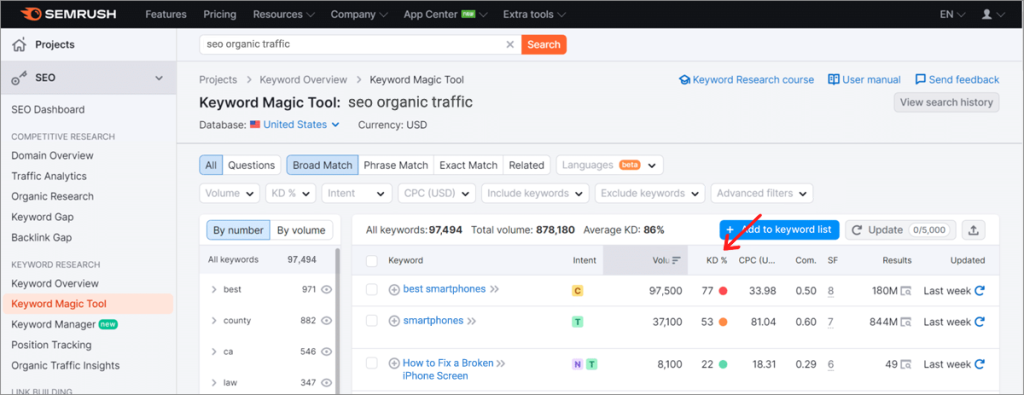
While there are no hard-and-fast rules, you should aim for keywords with low difficulty scores (below 30) and reasonable search volumes (above 0). Given that you can’t target thousands of keywords at once, begin with a manageable number—around 50 is a good start. The objective is to curate a set of terms that collectively, add value to your overall strategy.
Also Read: Technical SEO Issues: Common Reasons Why Your Website is Not Ranking on SERPs
Step 2: Creating Tens of Thousands of SEO Pages
Now comes the exciting part! After putting in the legwork to identify a solid head term for your programmatic SEO strategy, it’s time to turn that research into actionable, informative web pages.
- Create Your Template Page
The core idea of programmatic SEO is to create a templated web page that can be replicated and populated with unique data automatically. Your first task is to build this foundational template page.
If you’re looking for a straightforward way to accomplish this, we highly recommend using Webflow, a powerful no-code website builder. For those unfamiliar with it, Webflow sets itself apart as one of the most sophisticated tools in its category. It enables you to design and build virtually any type of website you can envision.
To make things easier, consider starting with one of Webflow’s pre-designed templates. You can find a template that matches your needs by visiting the following link:
After you’ve cloned one of Webflow’s templates, the next step is to customize what they refer to as a “collection page.” Please refer to their documentation on the collection pages for a broad understanding. These collection pages will essentially act as your template pages. In subsequent steps, you’ll learn how to personalize these pages using data from Webflow’s Content Management System (CMS).
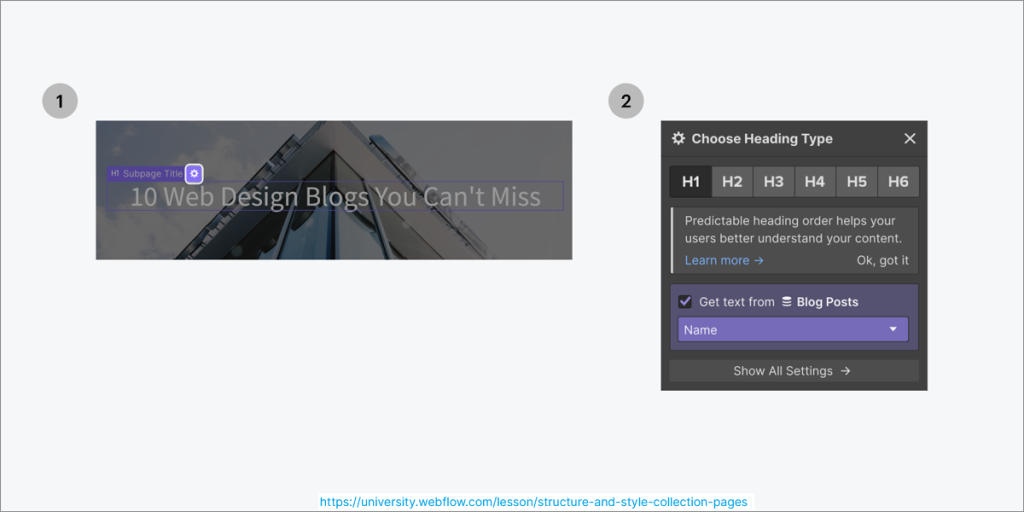
Example of Programmatic Location Pages
Let’s say you’re building a website for your travel agency and want to programmatically display vacation packages using Webflow. Here’s how to go about it:
- Begin by selecting a Webflow template that resonates with the theme of your own choice.
- Create a new CMS collection and name it.
- Tailor your template pages to feature the details of your trip packages, including key information like location, price, and itinerary.
- Utilize HTML embeds to dynamically integrate content into your website, ensuring that all displayed information is current.
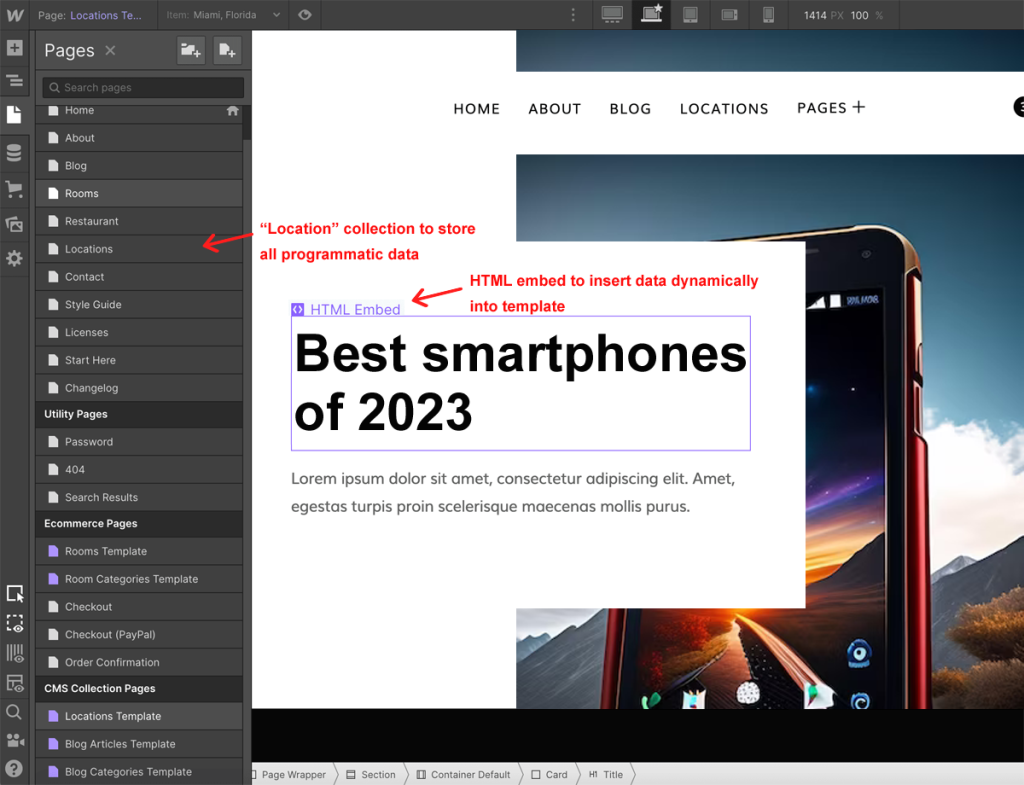
By following this methodology, you can automate the process of maintaining and showcasing your travel packages. This ensures that visitors to your site are always in the loop about the latest offerings.
- Collect Your Data
Once you’ve set up your template page in Webflow, the next step is to collect the data you’ll need to populate those pages. Let’s use an example to walk you through this process.
Starting With Airtable
Just as Webflow simplifies website creation, Airtable streamlines the process for databases. If you’re new to Airtable, it’s a leading no-code database and spreadsheet application. This is where you’ll collect all the data that will populate your website’s content.
Here’s how to get started with Airtable:
- Create an account on airtable.com.
- Copy the Airtable template from Whalesync’s pSEO Location Pages Template Pack.
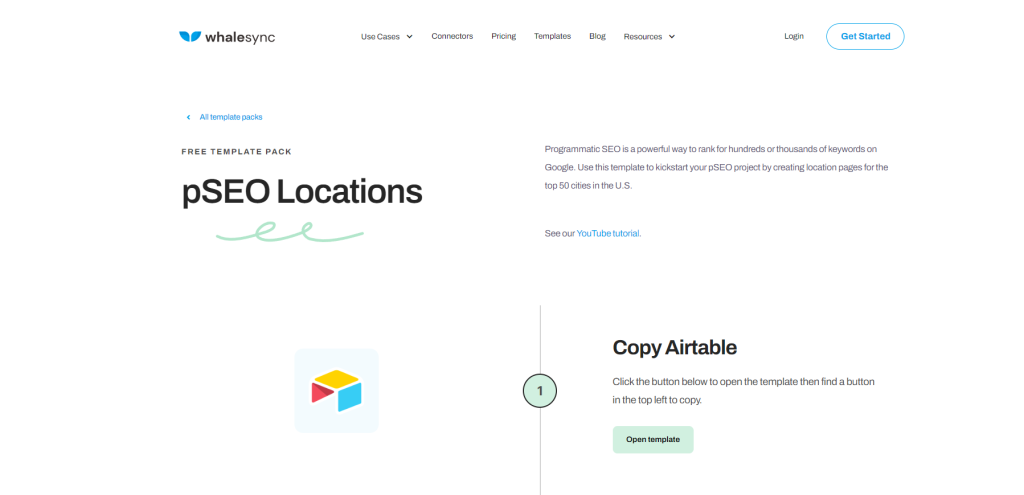
Getting Your Airtable Base Ready
After you’ve set up your base in Airtable, the next step is to tailor it to fit your specific needs. Each row in your base will correspond to a new page on your website. For instance, if you’re using the location example, each row could represent a different city.
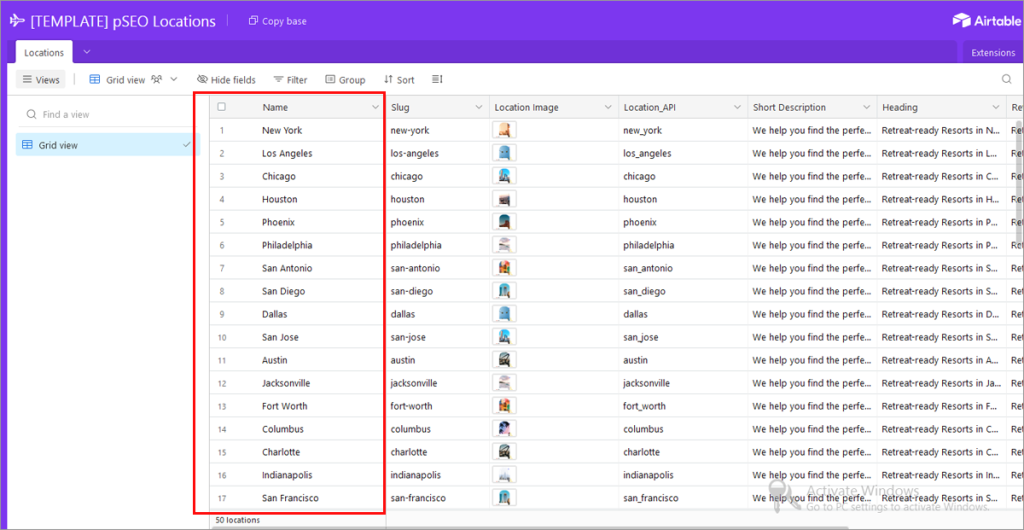
To customize your template pages, you’ll dynamically insert different types of data into each column of your base. In our location example, this could mean adding a brief product description or an image for each city.
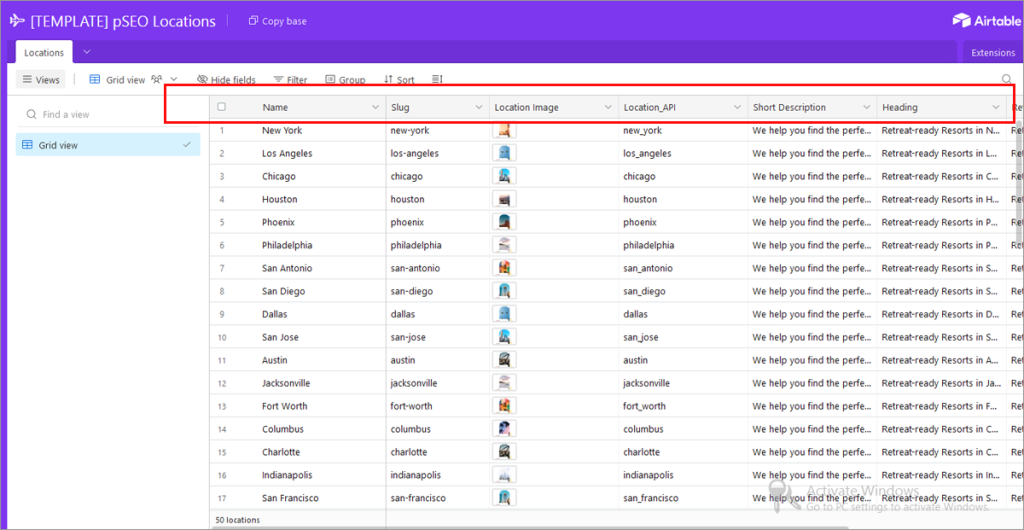
While the template serves as a strong starting point, don’t hesitate to leverage Airtable’s customization options to align the base with your unique requirements. For example, adding additional, unique data can enhance the SEO ranking of your programmed pages.
Collecting Your Data
Now that your Airtable database is prepared, it’s time to input data. If you’re dealing with fewer than 100 pages, you can manually enter the data, but for thousands of pages, automating the process is necessary.
We suggest using a tool called Data Fetcher, an Airtable extension that streamlines data retrieval from any API. It’s a good idea to explore Data Fetcher’s documentation to gain a deeper understanding of how to use their tool effectively.
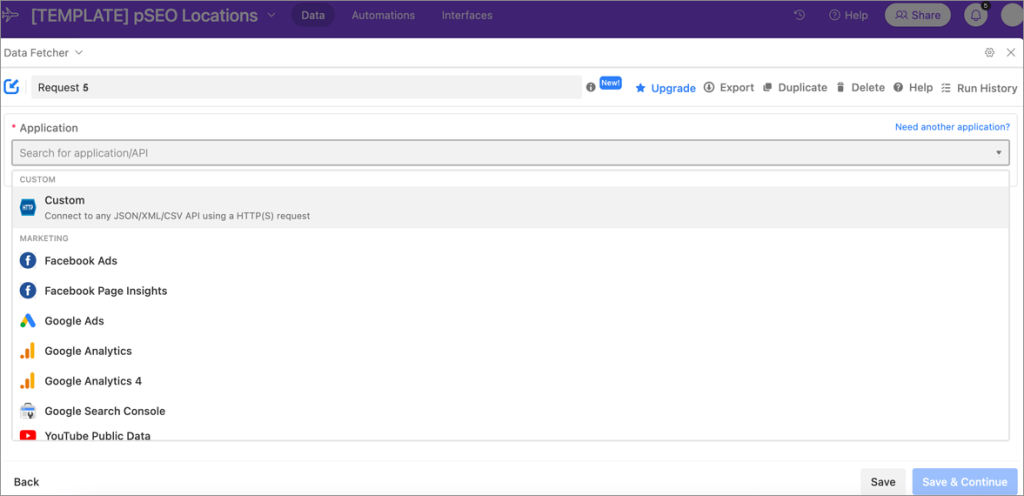
Whether you opt for manual data entry, the use of Data Fetcher, hiring a virtual assistant, or other approaches, it’s vital to get your data organized for your programmatic pages. If you’re unsure about the type of data to include on each page, begin with something simple. For instance, when dealing with location pages, you can start by copying and pasting a list of 100 cities into Airtable. Later, you can enhance it with unique descriptions and additional fields as needed.
- Build Many Pages Easily (With Whalesync)
With a well-designed template page in Webflow and a wealth of unique data stored in Airtable, you’re now ready to start creating your programmed pages.
Whalesync makes this process incredibly simple by enabling you to easily sync data from your Airtable database to your Webflow web pages. The first step here is to make sure that every field in Airtable corresponds precisely with its counterpart in Webflow.
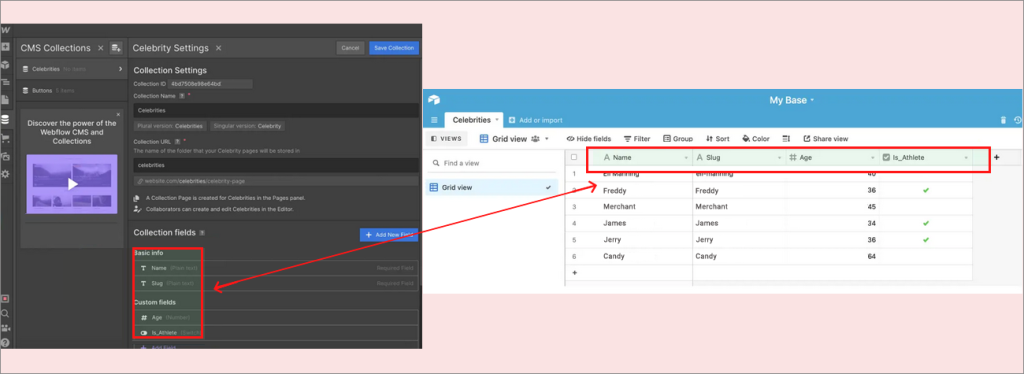
After you’ve aligned the fields in both applications, the next step is to link them together within Whalesync. Once the fields in both platforms match, you can proceed to connect them, making your programmatic SEO strategy a reality.
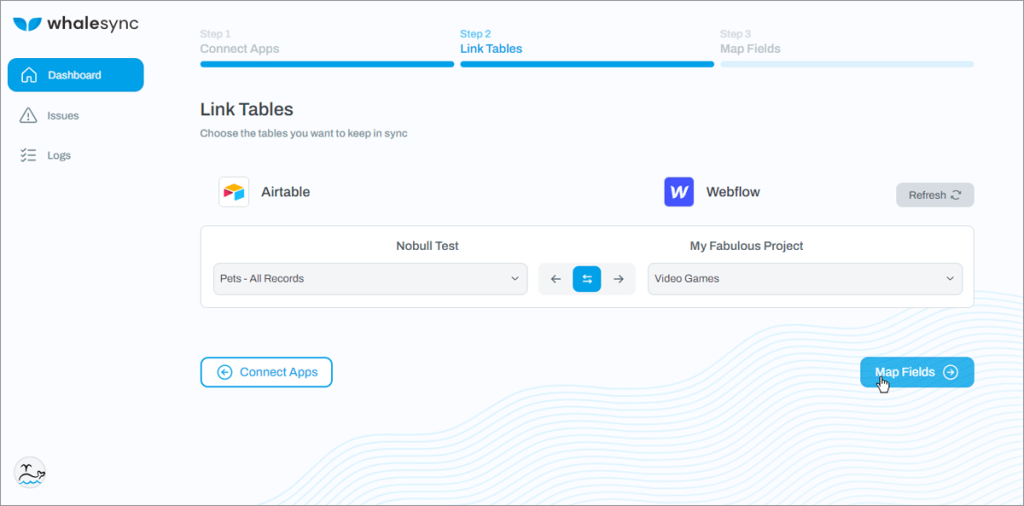
You’re all set once you’ve finished mapping your tables and fields. WhaleSync takes it from there. After that, you’ll see your page data syncing instantly from Airtable to Webflow, and it will automatically generate your programmatic pages for you.
- Enhance Your Pages with AI-Generated Unique Content
Creating hundreds of programmed pages using a few no-code tools is already an achievement. What makes it even more remarkable is our ability to leverage AI to generate unique content for each of these pages within a short time frame.
With our tech stack of Airtable, Webflow, and Whalesync, integrating AI-generated content becomes incredibly straightforward. All you have to do is input the AI-created content into Airtable, and Whalesync will handle the automatic synchronization with Webflow, displaying the content on your website.
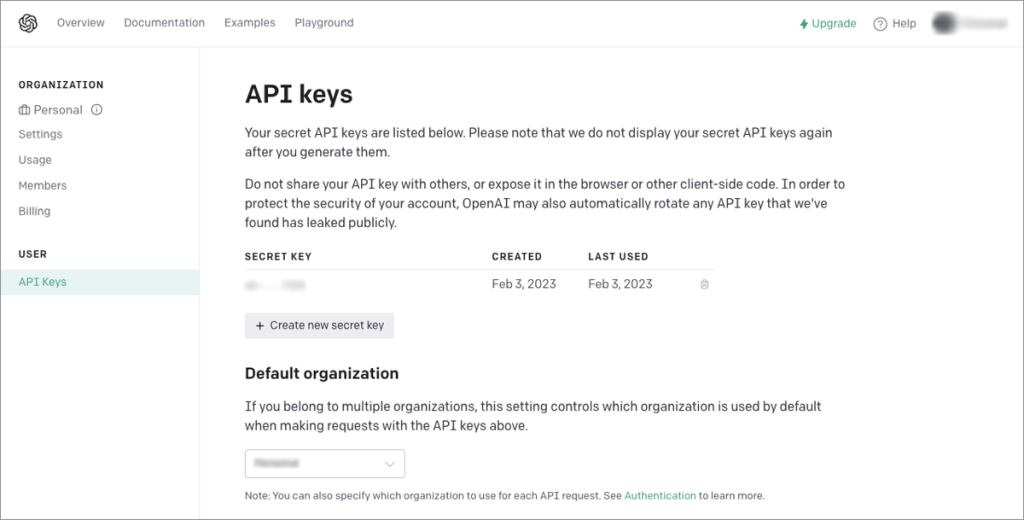
To start, create an account with OpenAI. Then, go to the API key settings and generate a new secret key. We highly recommend using Data Fetcher within Airtable once you have your OpenAI API key. This tool connects to OpenAI effortlessly, allowing AI to populate fields in your spreadsheet.
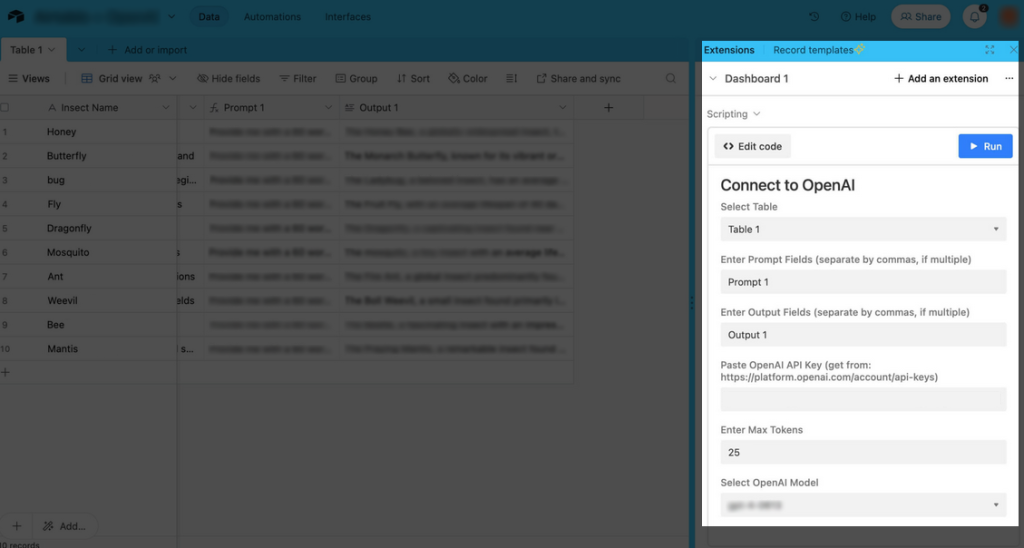
Take Camelia as an example: We instructed OpenAI to “write a localized short description for a marketing website specific to [city].” Data Fetcher then sent this request to OpenAI, which populated our Airtable base with tailored content for each city on our list.
Avoiding Common Programmatic SEO Problems
While well-executed programmatic SEO can deliver substantial benefits, it’s crucial to steer clear of common traps.
- Thin Content
Avoid thin content, as advised by Google’s guidelines. Websites that merely replicate product descriptions or reviews without adding new, valuable content can hinder your site’s SEO performance. Google prioritizes pages that provide comprehensive, meaningful information, so it’s essential to go beyond simple headlines and a few links.
- Non-Unique Content
Beware of non-unique content. Filling your website with poorly written paragraphs or copying content from competitors will not serve you well. Google highly values uniqueness; consistently featuring unoriginal content can jeopardize your SEO efforts.
- Poor User Experience
User experience should never be compromised, whether your website has one page or many. Google aims to serve valuable pages to its users, so a fast-loading, well-designed, and user-friendly website is crucial. There are no shortcuts here; taking the time to ensure your pages meet these standards is vital for a successful SEO strategy.
- Lack of Domain Authority
Addressing the issue of domain authority is crucial. Google tends to prioritize and rank pages from established websites with extensive connections. Low domain authority can be a hurdle for new websites, making it tough to outperform competitors with higher authority. To counter this, it’s essential to supplement your programmatic efforts with high-quality, meticulously crafted content.
While these manually created blog posts may not attract as much traffic as your programmatic pages, they play a vital role in boosting your domain authority and enhancing the search rankings of your programmatic content.
Conclusion
Successfully navigating the complex landscape of Programmatic SEO in 2025 demands a nuanced understanding of emerging algorithms, evolving user behaviors, and technological advancements. This comprehensive guide provides you with the critical insights, techniques, and tools needed to elevate your online presence. If you’re ready to build your programmatic SEO pages, you can start with Airtable, Webflow, and Whalesync by following the steps outlined above.
Programmatic SEO offers the potential for millions of impressions, benefiting both large corporations and individual entrepreneurs alike. While not a guaranteed silver bullet, it remains one of the most effective methods for rapidly increasing website impressions at a manageable cost.
As you begin your SEO journey, remember that adaptability and staying current with industry trends are key to long-term success in this ever-changing field.
FAQs
Is programmatic SEO suitable for e-commerce sites?
Absolutely. Programmatic SEO is particularly advantageous for e-commerce platforms. Its dynamic capabilities allow for efficient management of product listings, optimization of category pages, and responsiveness to shifts in consumer behavior, ultimately boosting online visibility.
Are there any potential risks or challenges associated with programmatic SEO?
Programmatic SEO does come with its set of challenges, including the need for continuous monitoring and algorithm adjustments. Other concerns might include data privacy issues and the balance required between automation and human oversight to maintain a well-orchestrated approach.
How can programmatic SEO adapt to the ever-changing world of search engine algorithms?
Programmatic SEO is highly adaptable to changing search engine algorithms, thanks to its real-time analytics and machine learning capabilities. These features enable quick adjustments to keep your website optimized and visible in search results.
What role does machine learning play in programmatic SEO?
Machine learning is integral to Programmatic SEO. It enables systems to learn and adapt based on patterns and user behavior. This technology aids in predicting changes in search engine algorithms, identifying key search terms, and more effectively optimizing content to enhance search rankings.
